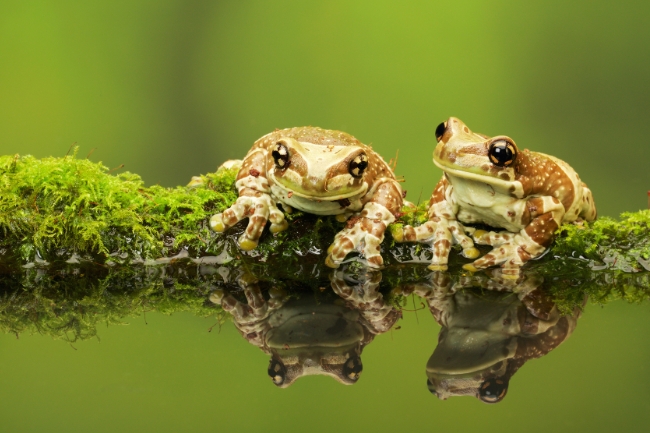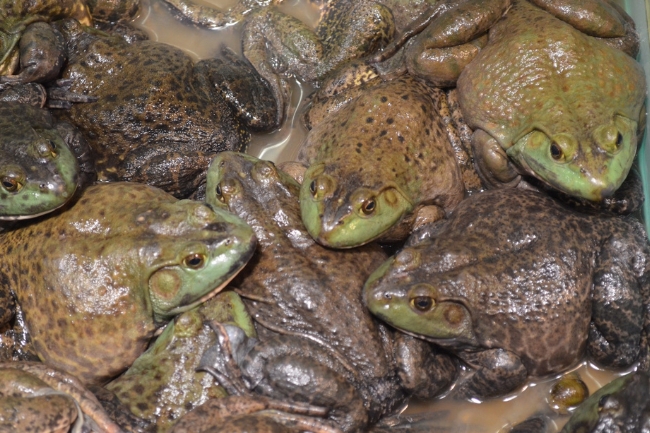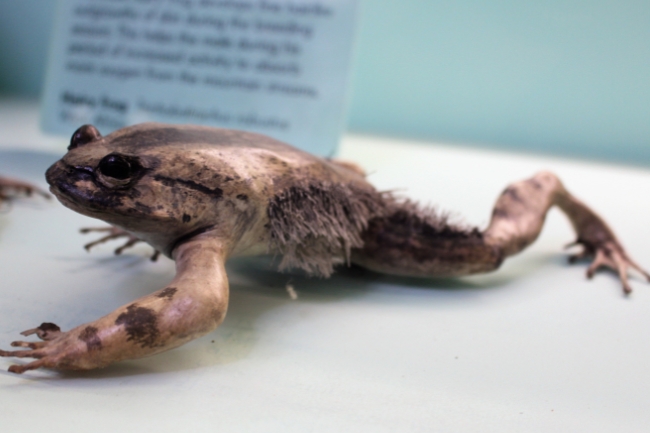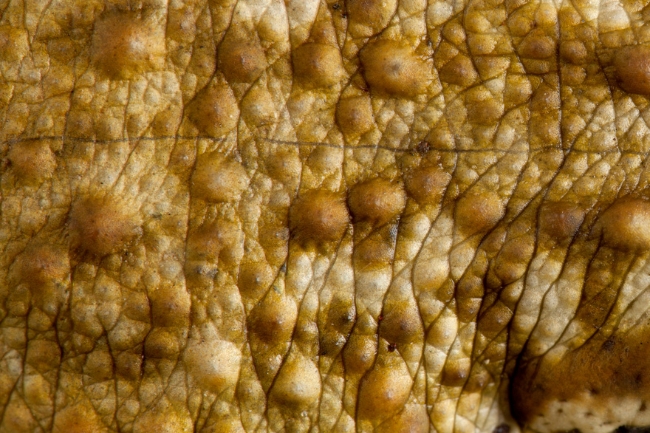Frogs do not have hair, this is because they don’t need it to keep warm, being cold-blooded animals.
Do frogs have hair?
There are roughly 7,000 species of frog across the globe. They live in a wide range of habitats, from forests, to wetlands, even to the attic tundra and deserts.

While frogs are highly diverse, having adapted to their many different living conditions, most species are hard to confuse with being anything other than a frog (or a toad of course).
One of the things that gives them their distinctive look is the smooth, slimy-looking skin. This skin in incredibly important for all frog species. It allows them to breathe, drink, hide from predators, give out warning signals and attract mates.
With all these important jobs that the frog skin has to do, hair follicles, would simply get in the way. In mammals, and other animals with hair follicles, hair is usually part of a strategy to keep warm, or in order to attract a mate.
| Frog Species | Hair-like Structures Present? | Description |
|---|---|---|
| African Reed Frog | Yes | African reed frogs have papillae, hair-like structures on their skin. These structures are actually dermal papillae, which help with camouflage and providing a rough texture to aid in gripping surfaces. |
| Tomato Frog | Yes | Tomato frogs have fimbriae, hair-like projections on their bodies. These fimbriae are specialized dermal structures that help with camouflage and increasing surface area for moisture absorption. |
| Fire-bellied Toad | No | Fire-bellied toads do not possess hair-like structures. They have smooth skin with colorful patterns and markings. |
| White’s Tree Frog | No | White’s tree frogs do not possess hair-like structures. They have smooth skin with various patterns and colors. |
For this first job, frogs do not have the ability to produce their own heat. Being cold-blooded animals, they take heat from the world around them. Order to regulate this heat they will move to cooler or warmer locations, so they can adjust their body temperature. This may mean diving into the water to cool down, or sitting on a lilypad in the sun to warm up.
With all this heat exchange required, hair with its insulating properties, would prevent them from effectively losing or gaining heat.
In terms of mating, many frogs use the art of song to secure their mate, with the males famous ‘ribbits’ well-known to us humans during mating seasons.

Of course looks are important too, but frogs are often near the bottom of the food chain, meaning they use colours such as greens and browns to help camouflage themselves from predators.
For those species that display bright colours, this is usually designed to put off predators, rather than attract a mate, as the bright colours and stunning patterns show that they are unpleasant to eat.
So with all these cons, and no real pros, frogs simply don’t need hair to go about their daily business.
Also read: Frogs in a Pond: What Do They Eat?
What is frog ‘hair’?
While frogs do not have hair, which is made of kerotin, the same substance our fingernails are made from, they do have hair-like structures on their skin.
These structures are too small to be seen with the naked eye, and are call cillia. Cillia are small protrusions on the skin that help the frog to swim through water with less effort.
They also help spread he mucus that coats the frog’s skin. While this mucus skin layer may sound bizarre to us, it helps the frog to keep from drying up, and also aids it to breathe through their skin.
| Frog Species | Hair-like Structure Function | Explanation |
|---|---|---|
| African Reed Frog | Sensory Perception | The papillae on African reed frogs provide sensory feedback, allowing them to sense movements and vibrations in the water. This helps them detect prey, predators, and potential mates. |
| Tomato Frog | Moisture Absorption | The fimbriae on Tomato frogs serve as extensions of the skin, increasing the surface area. This aids in absorbing moisture from the environment, helping them maintain hydration in their native habitats. |
| Fire-bellied Toad | N/A | Fire-bellied toads do not possess hair-like structures. Instead, their brightly colored bellies serve as a warning signal to predators, indicating their toxic nature. |
| White’s Tree Frog | N/A | White’s tree frogs do not possess hair-like structures. They rely on their large adhesive toe pads and excellent climbing abilities for arboreal locomotion. |
The hairy frog
The hairy frog is a bizarre looking species. It is so named, because what looks like it has some really impressive looking sideburns going down its body.

However, while this may look like hair, the hairy frog’s fancy hairdo is actually dermal papillae. Dermal papillae in humans are the kind of bulb that the hair sits within.
In this frog species the dermal papillae has become much longer and more hair-like, but it doesn’t have the separate hair follicles, which is made of keratin.
These structures are thought to act almost as gills, as they contain arteries and increase the surface area of the frog’s skin, allowing them to absorb more oxygen.
Within the hairy frog’s life cycle there is a need for this increased oxygen intake underwater, as the males spend an extended period of time submerged, while they look after the eggs.
Another strange-but-true aspect of this frog is that they have claws, which break the bones of their feet when they emerge.
These claws, which are made of bone, only emerge in high stress situations, such as if they are grabbed by a predator. It’s this strange ability which has given them the name of the wolverine frog.

Multipurpose skin
A frog’s skin is an important and multifunctional organ. There are many different services it provides the frog.
- Camouflage: frogs often choose to have patterns and colours on their skin that blend in to their environment, such as browns and greens. More than this their skin texture sometimes mimics the textures of the vegetation around us.
- Warning: frogs sometimes display bright colours or striking patterns in order to warn predators that they are poisonous.
- Protection: like all animals, their skin provides them with a certain amount of protection from the elements.
- Drinking: frogs can drink water through their skin.
- Breathing: frogs can also breath through their skin.

The most bizzare services the frog’s skin provides is its ability to let the frog breathe and take in water.
Frog’s are able to breathe through their skin due to how thin the skin is, and the presence of blood vessels close to the surface. Gases exchange through the skin layer, with carbon dioxide being released and oxygen being taken in.
During their tadpole stage frogs take in oxygen both through their skin and their gills, however they lose their gills as adults and breathe through their nose, mouth and skin instead.
Because of their relatively thin skin, frogs are at risk of dehydration through water loss. This is one of the reasons that they are heavily associated with wetlands and damp habitats.
In order to make up for this water loss it’s important they drink lots. However, rather than slurping up their water with their big tongues, they simply sit themselves in a puddle and absorb the water through their skin.

Similar to the oxygen exchange, the skin is thin enough, and blood vessels close enough to the surface, to allow water to filter through. An amazing ability for our amphibian friends.
Fuzzy frogs
While the idea of a hairy frog may have a certain comic appeal, like a hopping guinea pig that hangs around ponds, they have evolved to cope with the stresses of the world in a very different way from animals that have hair.
So while frogs are diverse enough that a hairy amphibian may one day appear, so far these hopping, ribbiting and bobbing creatures have decided that bald is a good look for them. And who would disagree?

